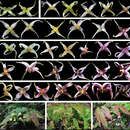en
names in breadcrumbs


The genus Berberis, commonly known as the barberries, includes 700 species of shrubby plants found throughout temperate and subtropical Eurasia, Africa and the Americas.About 200 of these have compound leaves, and traditionally have been classified as a separate genus, Mahonia, but more recent molecular analyses indicate that this separation is not founded and that the simple leaved group (true Berberis) is polyphyletic with respect to the compound leaf group (Kim et al. 2004 and studies cited within). Species numbers are in debate, and efforts are ongoing to compile a complete list and database of taxa (Ulloa 2014). Berberis is the largest of the 16 genera in the basal eudicot family Berberidaceae (Kim et al. 2004).
Species diversity is greatest in South America, Africa and Asia; Europe and North America have native species as well. The most well-known Berberis species is the “European” barberry, Berberis vulgaris, which is common from North Africa and Europe through central Asia.Barberries have been cultivated for gardens; several of the most common cultivars are: B. darwinii, B. dictyophylla, B. julianae, B. thunbergii, and B. verruculosa (Wikipedia 2014).
Barberry species grow to between 1-5 meters (3-15 feet) in height, and there are deciduous and evergreen species.Many of the species have spines on the shoots and along the margins of the leaves.Many produce small berries, either elongate or spherical, that are edible and nutritious, if sharply sour.While not common in European cuisine, Iranian dishes frequently use the berries of B. vulgaris.The symbols of Patagonia are Calafate (B. microphylla and the similar B. heterophylla), and Michay (B. darwinii), the dark blue berries of which are made into jams and eaten fresh in Argentina and Chile.Bark, root bark and berries of Barberry species have a long history of medicinal use in multiple cultures for symptoms such as diarrhea, fever, upset stomach. Active chemical components are isoquinolone alkaloids, especially berberine, which shows antimicrobial, anti-inflammatory, hypotensive, sedative, anticonvulsant and antioxidant effects (Wikipedia 2014; Erlich 2013).
The Berberidaceae are a family of 18 genera of flowering plants commonly called the barberry family. This family is in the order Ranunculales. The family contains about 700 known species,[1] of which the majority are in Berberis. The species include trees, shrubs and perennial herbaceous plants.
Alloberberis C. C. Yu & K. F. Chung
Berberis L. — barberry
Mahonia Nutt. — Oregon grape (eastern Asia, the Himalaya, North and Central America)
Moranothamnus
Nandina Thunb. — heavenly bamboo (eastern Asia from the Himalaya to Japan)
Caulophyllum Michx. — blue cohosh
Gymnospermium Spach
Bongardia C. A. Mey.
Achlys DC. — vanilla-leaf
Diphylleia Michx. (southern Appalachian mountains, northern Japan, and China)
Dysosma (China)
Podophyllum L. — mayapple (eastern North America)
Sinopodophyllum (Afghanistan, Bhutan, northern India, Kashmir, Nepal, Pakistan, Tibet, and western China)
Epimedium L.
Vancouveria Morren & Decne. — inside-out flower (western U.S.)
Jeffersonia W. Bartram — twinleaf
Plagiorhegma Maxim.
Leontice L. (Middle East to Central and Western Asia)
The APG IV system of 2016 recognises the family and places it in the order Ranunculales in the clade eudicots.[2]
In some older treatments of the family, Berberidaceae only included four genera (Berberis, Epimedium, Mahonia, Vancouveria), with the other genera treated in separate families, Leonticaceae (Bongardia, Caulophyllum, Gymnospermium, Leontice), Nandinaceae (Nandina), and Podophyllaceae (Achlys, Diphylleia, Dysosma, Jeffersonia, Podophyllum, Ranzania, Sinopodophyllum).
Mahonia is very closely related to Berberis, and included in it by many botanists. However, recent DNA-based phylogenetic research has reinstated Mahonia, though with a handful of species transferred into the newly described genera Alloberberis (formerly Mahonia section Horridae) and Moranothamnus (formerly Mahonia claireae).[3] Species of Mahonia and Berberis can be hybridised, with the hybrids being classified in the genus × Mahoberberis.[4][5]
Diphyllaea is closely related to or perhaps embedded within Podophyllum. Instead of the current trend to subdivide Podophyllum into three genera (Podophyllum, plus Dysosma and Sinopodophyllum), inclusion of Diphyllaea in a larger Podophyllum is equally warranted.
Berberis pinnata (California barberry)
Berberis darwinii (calafate or michay)
Berberis empetrifolia, fruit
The Berberidaceae are a family of 18 genera of flowering plants commonly called the barberry family. This family is in the order Ranunculales. The family contains about 700 known species, of which the majority are in Berberis. The species include trees, shrubs and perennial herbaceous plants.